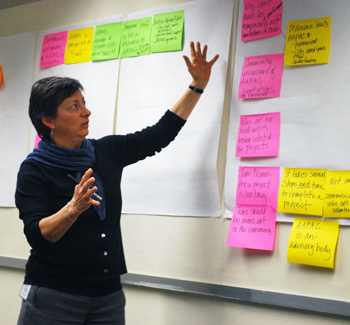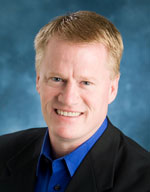Ann Arbor public art commission meeting (Oct. 26, 2011): Commissioners were briefed on two possible public art projects at their monthly meeting: a partnership with the Detroit Institute of Arts, and the potential for incorporating public art into a rain garden on property the city is buying at First & Kingsley.

Connie Pulcipher of the city's systems planning staff led the public art commissioners in a discussion to prep for a November working session with the city council. (Photos by the writer.)
But most of their 2.5-hour meeting was spent prepping for a Nov. 14 working session with Ann Arbor city council, focusing on the city’s Percent for Art program.
The council working session was prompted in large part by a resolution proposed by councilmember Sabra Briere, which she brought forward at the council’s Sept. 19 meeting. The resolution would revise the city’s public art ordinance explicitly to exclude sidewalk and street repair from projects that could be tapped to fund public art. It would also require that any money allocated for public art under the program be spent within three years, or be returned to its fund of origin. The council ultimately postponed action on the resolution until its Nov. 21 meeting, with a working session scheduled in the interim to focus on the Percent for Art ordinance.
The timing of the proposed ordinance change is related to two proposals on the Nov. 8 ballot: (1) renewal of a 2.0 mill tax to fund street repair; and (2) imposing a 0.125 mill tax to fund the repair of sidewalks – which is currently the responsibility of adjacent property owners.
At AAPAC’s Wednesday meeting, Connie Pulcipher of the city’s systems planning unit led commissioners in a discussion to organize their thoughts before the council work session. She asked them to identify the program’s biggest challenges, from the community’s perspective, as well as the primary causes and possible solutions to those challenges.
Commissioners cited a range of issues, including: (1) a lack of public awareness about the program, its constraints, funding sources, and AAPAC’s role; (2) the perception that not enough art is coming out of the program, and that the process is too slow; (3) the complaint that local artists aren’t given preference; and (4) the sense that in this difficult economy, city funds shouldn’t be spent on public art.
In addition to offering ways to address these challenges, commissioners also discussed their own workload. They noted that AAPAC is still relatively new and is one of the few city commissions that hasn’t enjoyed consistent staff support over the years. Although a new part-time public art administrator was hired this summer, the program had no dedicated staff person for about a year.
Wednesday’s meeting began with two presentations. Larry Baranski of the DIA talked about how Ann Arbor might participate in the museum’s Inside|Out project, which involves installing framed reproductions from the DIA’s collection at outdoor locations on building facades or in parks. Also, Patrick Judd of Conservation Design Forum and Jerry Hancock, Ann Arbor’s stormwater and floodplain programs coordinator, floated ideas for possible public art in a rain garden that’s being designed for property at the corner of Kingsley and First, located in a floodplain. Commissioners were generally receptive to both ideas, but plan to discuss them in more depth at their monthly meeting in November. [Full Story]







